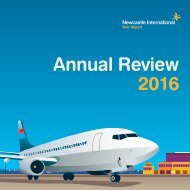Airport Masterplan 2035 LOW RES
You also want an ePaper? Increase the reach of your titles
YUMPU automatically turns print PDFs into web optimized ePapers that Google loves.
<strong>Masterplan</strong> <strong>2035</strong><br />
10.64 Whilst the above reductions are achievable we are aware<br />
that the target may be more challenging if the <strong>Airport</strong><br />
expands.<br />
10.65 As part of the delivery of this <strong>Masterplan</strong> we will develop<br />
a carbon and energy reduction strategy to map detailed<br />
long term actions to reduce our carbon footprint, including<br />
from new development. The strategy could include carbon<br />
foot printing to fully understand and quantify our carbon<br />
output, and therefore the effectiveness of mitigation<br />
measures. The possibly of doing this as part of the <strong>Airport</strong><br />
Carbon Accreditation Program will be considered, which<br />
is based on evidencing mapping, reduction, optimisation,<br />
and neutralising of carbon emissions. We will also explore<br />
the possibility of introducing energy reduction targets<br />
alongside those for carbon reduction in the <strong>Masterplan</strong>.<br />
10.66 We recognise that efficiency improvements can only go so<br />
far to reduce our carbon output and as the <strong>Airport</strong> grows<br />
there may be a need to reduce carbon output through the<br />
generation of renewable and/or low carbon energy.<br />
10.67 We consider that the <strong>Airport</strong> has much potential for on-site<br />
energy generation, particularly given its large land holding,<br />
with much land to the north currently in agricultural use.<br />
This land could be used for renewable energy production<br />
and will be safeguarded for this purpose. Developments<br />
could be -<br />
l A solar farm;<br />
l Commercial scale wind turbines;<br />
l Crop rearing for the production of bio-fuels for use on<br />
or off-site.<br />
10.68 We believe there is also opportunity to increase use<br />
of small scale on-site renewable or low carbon energy<br />
production incorporated into new developments and<br />
retrofitting onto existing infrastructure. This could include –<br />
l Solar photovoltaic panels;<br />
l Vertical axis and column mounted wind turbines;<br />
l Biomass fired on-site combined heat and power<br />
boilers (CHP) or combined heat, power and cooling<br />
(CCHP) units;<br />
l Air source heat pumps.<br />
10.69 The technical and financial viability of these schemes will<br />
be a key consideration as to whether they can be delivered,<br />
as well as potential safeguarding issues to ensure the safe<br />
operation of the airfield isn’t compromised.<br />
10.70 Building Regulation requirements dictate demanding<br />
efficiency and carbon reduction standards for the<br />
development of new buildings and extensions to existing<br />
ones. Alongside meeting these standards we will also<br />
reasonably consider ‘passive design measures’ to ensure<br />
that the orientation of new buildings, the arrangement<br />
of internal space, and their design maximises the use of<br />
natural light and ventilation to reduce the need for artificial<br />
alternatives. We will also explore the possibility of meeting<br />
industry recognised standards, such as BREEAM, for<br />
suitable developments, principally the employment sites<br />
south of the runway.<br />
10.71 The <strong>Airport</strong>’s fleet of vehicles are already being<br />
benchmarked for vehicle fuel efficiency and carbon<br />
output in selecting new vehicles. The carbon and energy<br />
reduction strategy will explore options such as the use<br />
of electric and automated vehicles, and the moving away<br />
from fuel powered auxiliary power units on the airfield, to<br />
fixed electrical ground power. In addition, as set out in the<br />
surface access strategy we will also look to expand electric<br />
vehicle charging facilities in line with demand.<br />
Biodiversity<br />
10.72 The <strong>Airport</strong> is committed to ensuring that development to<br />
deliver the <strong>Masterplan</strong> carefully considers the potential<br />
impact on biodiversity and that any impact is appropriately<br />
mitigated.<br />
10.73 Although the fenced airfield is low in ecological value,<br />
the wider <strong>Airport</strong> site contains a broad range of habitats,<br />
including hedgerows, mixed and broadleaf plantations,<br />
scattered trees, and scrub and fenland. Wildlife habitat is<br />
particularly concentrated to the south of the <strong>Airport</strong> site.<br />
10.74 The ‘Wildlife and Countryside Act 1981’ (as amended) is<br />
the primary legislation for the protection of habitat and<br />
species. Whilst ‘The Conservation of Habitats and Species<br />
Regulations’ (2010), offers protection to a number of plant<br />
and animal species throughout specific conservation<br />
designations, which are close to our eastern approach<br />
paths.<br />
10.75 There are a number of protected habitats close to the<br />
<strong>Airport</strong>, but none on the site itself. Big Waters, Brenkley<br />
Meadows, and Prestwick Carr are ‘Sites of Special<br />
Scientific Interest’ (SSSIs), and Sunniside Pond, Dinnington<br />
Road Fen, Havannah Nature Reserve, Moorey Spot Pond,<br />
Woolsington Hall, Prestwick Burn, and Foxcover Wood,<br />
are all either sites of Nature Conservation Importance or<br />
82<br />
83




